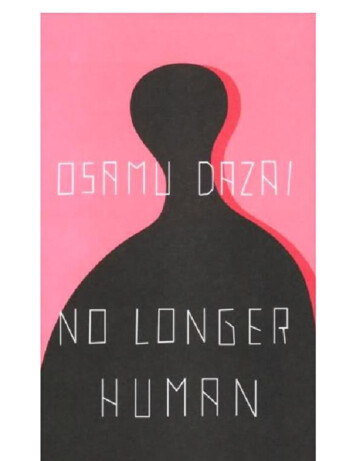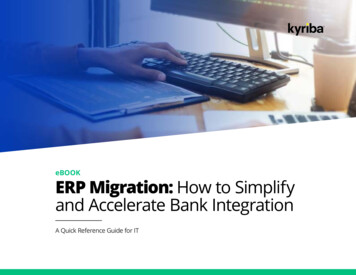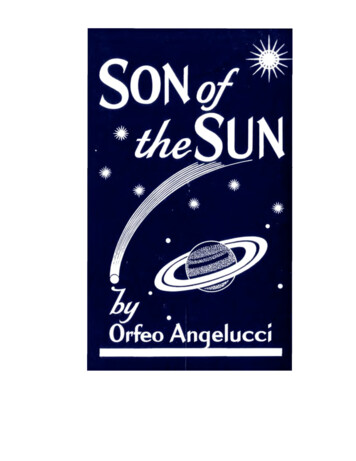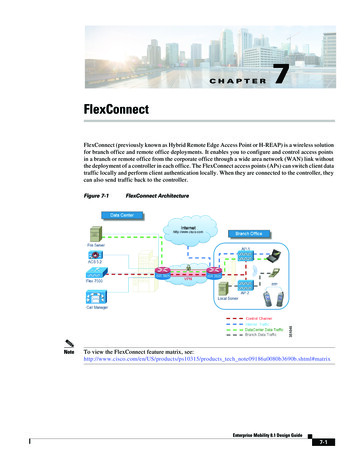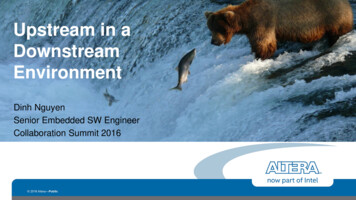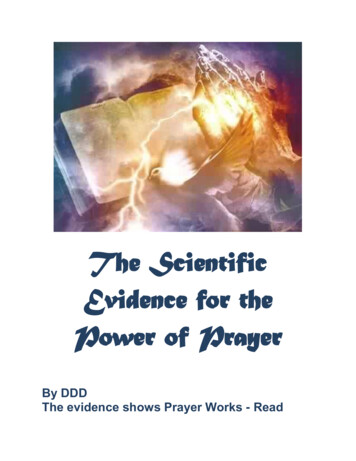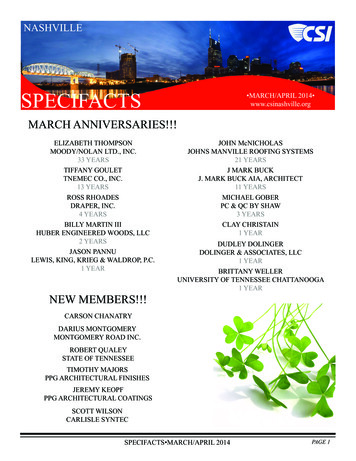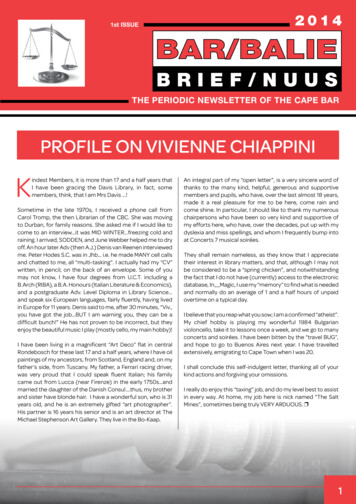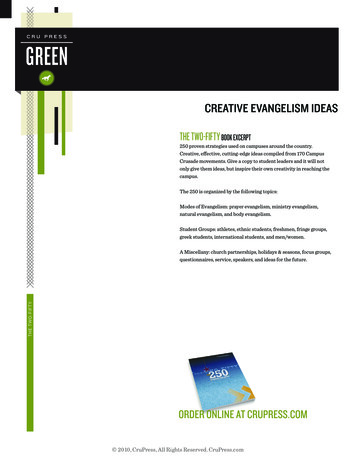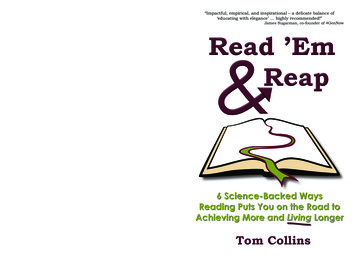
Transcription
Your Brain on Books! And Your Body, Too!– Pamela Wilson, author of Master Content Marketing andMaster Content Strategy– David Gower, Founder, New Clean Earth, LLC and YoubicwitusTM& Reap“Read ‘Em & Reap provides an important reminder of the manybenefits of reading. Part of its value comes from being a short, easyto read treatment, yet I found myself reacting to several researchrevelations with variations of, ‘Cool! I didn’t know this .’ This bookwill inspire others, as it has me, to read more.”Read ’Em“This book will help you to re-frame the time you spend reading.Read ‘Em and Reap [shows] you not only why reading helps you livelonger, but what to read, and how to read so you can benefit fromthe longevity effect regular reading delivers.”“Impactful, empirical, and inspirational – a delicate balance of‘educating with elegance’ highly recommended!”“Whether you read for work or for fun, this powerful little book willaffirm the benefits . of both! Because of Read ‘Em & Reap, I’mreading more these days and feeling less guilty about reading forleisure/escape. How’s that for impact?!”– Sybil Stershic, author of Taking Care of the People Who Matter Mostand Share of Heart, Share of Mind– Bruce Peters, entrepreneurial guide andfounder of Beyond Teal: Transform Life at WorkTMFrom Tom Collins: Read ‘Em & Reap grew from researchon changes in our learning habits, increasing longevity,emerging science of lifelong brain plasticity, and realitiesof multi-generational work/life relationships – all shapingmy work as “Chief Guide Dog” at Old Dog Learning.Reading dominated my 25-year legal career in research,writing, and oral argument. It remained central tostaying current in my subsequent entrepreneurial rolesin business consulting, book publishing, and co-founding a pet industryventure that ended in a Fortune 500 acquisition. It continues as a keyto adding more “dots” I can connect with my experience when helpingindividuals and teams who feel stuck learnwhat they need to find their path forward viaour Professional Learning Partnerships.www.OldDogLearning.comTom Collins“There is so much in the book to commend it, reminders for all thereasons to read, leading to Tom’s call to ‘Take Action’ -- which maylead you to friends old and new, vibrant conversations, and as inmy case, feeling compelled to write!”James Sugarman, co-founder of 4GenNowRead ’EmReap&6 Science-Backed WaysReading Puts You on the Road toAchieving More and Living LongerTom Collins
Early praise for Read ‘Em & Reap:“Whether you read for work or for fun, thispowerful little book will affirm the benefits .of both! Because of Read ‘Em & Reap, I’mreading more these days and feeling less guiltyabout reading for leisure/escape. How’s thatfor impact?!”– Sybil Stershic, author of Taking Care of the PeopleWho Matter Most and Share of Heart, Share of Mind“Spectacular news! This book will help youto re-frame the time you spend reading strategically to help keep you in tip-top cognitiveshape. Read ‘Em and Reap will show you notonly why reading helps you live longer, but whatto read, and how to read so you can benefit fromthe longevity effect regular reading delivers.”– Pamela Wilson, author of Master ContentMarketing and Master Content Strategy“Read ‘Em & Reap: impactful, empirical, andinspirational are just three adjectives I’d useto describe Tom Collins’ new book. Tom hasachieved a delicate balance of “educating withelegance,” and I highly recommend this book. it might wean you off the iPad, after all.”– James Sugarman, co-founder, 4GenNowintergenerational entrepreneurship organization
“Brilliant! The whole concept of Read ‘Em & Reapis so needed. I truly appreciate the intelligentnudge it’s given me to make more time to read!”– Mia Voss - Mia On The Go, StorytellerLuxury Travel & Lifestyle WriterBrand Promoter & Speaker“Read ‘Em & Reap is an important reminderof the many benefits of reading, as well ahelpful introduction to the love of reading forthose who haven’t yet engaged with books.Part of its value comes from being a short,easy to read treatment, yet I found myselfreacting to several research revelations withvariations of, ‘Cool! I didn’t know this .’“This book will inspire others, as it has me,to read more and would make a wonderfulintroductory book for those new to book clubs,starting high school or college, embarking oncareer learning programs, etc. With all the thingspeople do to improve and extend their lives, it’sgreat that reading is one and, hey, it might evenmotivate you to a better diet and more exercise!”– David Gower, Founder, New CleanEarth, LLC and YoubicwitusTM
“It’s no surprise to me that Tom Collins has writtenRead ‘Em & Reap. From our many conversationsover the years, he’s simply the right person atthe right time. . There is so much in the bookto commend it, reminders for all the reasons toread, leading to Tom’s call to ‘Take Action’ –which may lead you to friends old and new,vibrant conversations, and as in my case, feelingcompelled to write!”– Bruce Peters, entrepreneurial guide and founderof Beyond Teal: Transform Life at WorkTM“Bravo! Read ‘Em & Reap is a winner! I’ll besharing it.”– Shawna Schuh - Ignite executive coaching,speaker, and author of 51 Ways toPick Up Your Get-Up-And-Go
WME Booksimprint ofOld Dog Digital, LLCBinghamton, NY, USA
Read ‘Em & ReapCopyright 2019 by Tom CollinsISBN: 978-1-934229-36-1Published in USA by Old Dog Digital, LLC, Binghamton, NYunder its WME Books imprintEditor: Yvonne DiVitaInterior & Cover Designer: Tom CollinsFor special orders and bulk discounts contact:tom@OldDogLearning.comDisclaimers:While the author and publisher have used their best efforts in preparing this book, they make no representationsor warranties regarding the accuracy or completeness ofthe contents of this book or any related, referenced, orlinked materials. The author and publisher specifically disclaim any implied warranties of merchantability or fitnessfor a particular purpose, and make no guarantees whatsoever that you will achieve any particular result.We believe all information, scientific research, and casestudies and results persented herein are true and accurate, but we have not independently audited or confirmedthe research methods, data collection, or results reported.Any advice or strategies contained in this book might noteven be suitable for your situation and you should consultyour own advisors as appropriate.
For Yvonne, whose love, support, and inspirationmake everything both possible and worth it.vii
viii
Gratitudes“I just want to thank everybodywho made this day necessary.”— Yogi BerraAs many have lamented, it’s not possible to thankeverybody who deserves my gratitude, not even if Itry to focus only on those who influenced this book.I do recognize the irony that my own thesis on theimpact of reading means I owe thanks to a significantswath of humanity over the last 6,000 years or so.Apologies to all those I’m inevitably omitting. Forthose still living, let’s (re)connect and I can thank youin person or online. I’ll set up a page on my blog foryou to leave a comment and we can go from there.Here, I’ll start with thanks to my dear friendand mentor, Bruce Peters, whose deeply satisfyingconversations and probing questions over many yearshelped make the writing of this book necessary.He knows what we mean by necessary! And to LeeThayer, who added that nuance to our lexicon.To Pamela Wilson for all she’s taught me aboutdesign and business over the years; for the link shareon Facebook that turned this idea into a project; forix
her feedback that forced me to rethink and rewritewhat are now Chapters 7-9; and for her Foreword.To Sybil Stershic, James Sugarman, DavidGower, Mia Voss, Dino Dogan, Brenda Lidestri, andShawna Schuh, for reading and critiquing earlydrafts. Their contributions to making this bookmore readable and more useful are immense. All it’sremaining faults are mine alone. My only excuse isknowing that at some point you have to stop and“let the baby be born” and this was my judgment.To the authors of all the books I’ve read,especially those cited directly in this one. I’llsimply call out Katie Myers, Kimberly Alexander,Anastasia Button, Erika Armstrong, and Eric Meadeas authors I got to meet personally while we lived inColorado, whose vibrant spirits and the books theypublished helped inspire me to get this one done!I’ll amend the thanks to the authors of all thebooks I’ve read or cited. No, to the authors of allthe books. Period. To understand why, skip to theConclusion and find the quote I shared from Galileo.Then turn that page to my Marvel-esque “extra” scene.To my family and the blended one I now sharewith Yvonne. You’ll see more in the Introductionhow my Mom drove my earliest reading. And my Dadinstilled my DIY-er mentality that pretty much anyproblem is “figure-out-able” with the right manual.To my two kids, Brendan and Elizabeth, whoseinsatiable curiosity kept me on my toes and madelife-long learning necessary for me, too.x
And to Yvonne’s three, Chloe, Maggie, and Don,who accepted me into their lives and inspired mewith their varied approaches, stimulating talks, andoccasionally challenges to my own thinking – alwaysa valuable gift.To Yvonne . . . well, she’s here by my side andthere aren’t enough trees left to thank her properlyin print, so I’ll just have to try my best to show her.xi
ContentsDedication – viiGratitudes – ixForeword – xvPreface: on Deep Reading (and “MWe”) – 1Deep reading as an interactive process – 2The mind we share – 5My side of MWe – 8CUE your side of this synapse – 11Introduction – 13Readers are . – 15Your brain on books (and your body, too) – 16Ch. 1 - Reading Reduces Stress – 19A double-edged sword – 19Reducing negative stresshelps more than our careers – 22Reaping the stress-reducing rewards of reading – 24Fact or fiction? – 25Ch. 2 - Helps You Sleep – 29More than physical restoration – 31What’s reading got to do with sleep? – 33xii
Ch. 3 - Improves YourDecision-Making Capacity – 35Reading grows your brain – 36Acquiring “the Knowledge” – 37Two side notes on growingyour brain through learning – 40Fiction increases perspective, comprehension,and readiness to take action – 41Building your “reading brain circuit” – 42Ch. 4 - Makes You a Better Leader – 45Empathy as a core leadership skill – 47Read, that’s an order! – 52Ch. 5 - Makes You Smarter – 53The more you read, the more you know – 54Reading improves yourbrain’s processing power, too – 56Ch. 6 - Helps You Live Longer – 61How much longer? – 62The future is already here – 63How reading helps you live longer – 67Reading as a life multiplier – 69Ch. 7 - Print or Digital – 71Some advantages of print – 72Music to your eyes – 74Some downsides of digital – 77Remedial reading? – 79xiii
Ch. 8 - Adopt Your Own Reading Plan – 813 tips for adding morereading to your life – 85Bonus tip:Subscribe, strategically – 89Ch. 9 - Take Action – 93Conclusion: As You Read – 101Indexed References – 109xiv
ForewordWant to live longer?“Alternate between an hour of aerobic exerciseand an hour of strength training every day.”“Sleep at least eight hours every night.”“Eat eight portions of vegetables and fiveportions of fruit every day.” “Eat red meat.”“Follow a plant-based diet.”Actually . “Don’t eat at all – fast.”When it comes to longevity advice, we haveheard it all. Sometimes the same “live longer tips”we heard just last year are contradicted by thisyear’s newest study.That’s why, when Tom Collins mentioned ahabit I already cherish – reading – might actuallyhelp me live longer, I was delighted.For those of us who already love to read, thisis spectacular news. This book will help youto re-frame the time you spend reading not aspassive downtime, but rather active “uptime”you’re using strategically to help keep you intip-top cognitive shape.If you’re someone who enjoys reading but lacksmotivation to do it regularly, this book will light axv
fire under you to schedule regular reading timeand stick to it.If you’ve ever wondered whether readingprint or digital made a difference, you’ll findsome answers in these pages. And if you’vewondered whether your entertainment orsports magazine was going to help boostyour brainpower, you’ll find that answer,too (but you may not like it!).All in all, Read ‘Em and Reap will showyou not only why reading helps you livelonger, but what to read, and how to readso you can benefit from the longevity effectregular reading delivers.Here’s to a long, healthy, word-filled future!— Pamela WilsonFounder, BIG Brand SystemNashville, TN March, 2019xvi
Preface: onDeep Reading(and “MWe”)“Deep reading . is a process ofinquiry built around the explorationof ‘challenging questions’ and‘troublesome knowledge.’ ”— Patrick Sullivan“We are an inherently collaborativespecies . collaboration is at the heartof what MWe can do .”— Dr. Daniel J. SiegelYou’ll find the term “deep reading” mentionedthroughout this book. In fact, for you to enjoymany of the benefits of reading we’ll be exploring,the science suggests that deep reading is key.When I ran into the term in my research, I feltI understood it and you would, too. But then,readers of earlier drafts posed one of those“challenging questions” to me:What do we really mean by deep reading?
Read ‘Em & ReapTom CollinsDeep reading as aninteractive processTurns out to be more complicated than Ithought, as well as a controversial topic inacademic and political circles. I’m not goingto delve into the politics here and will touchon the academic disputes only to note twomain approaches to reading that you mightthink of when you see the term deep reading.One is labeled “close reading,” where thereader carefully examines a text to find itsmain points, themes, or ideas, and identifythe arguments, evidence, or narrative thatsupports or conveys the meaning. Thisapproach assumes there is a single,objectively discoverable meaning in the textitself, resulting in the one right answer thatstandardized testing depends on.Critics decry this as an “answer-gettingdisposition,” where the reader is extractinga fixed meaning from the text.Even critics of answer-getting agree thatclose reading is a useful part of a reader’sskillset. But they object to stopping there,to limiting the role of the reader to a passiverecipient of meaning.The second approach ascribes to readers a“problem-exploring disposition” and more fullycaptures what I mean using the term “deepreading.” This approach treats the reader asan active participant in constructing meaning2
Preface:onDeep Reading (and “MWe”)from text. In Deep Reading: Teaching Readingin the Writing Classroom, the editors build onLouise Rosenblatt’s theory of reading as“an event in the life of a reader, asa doing, a making, a combustionfed by the coming together ofa particular personality and aparticular text at a particular time.”This “coming together” is unique to eachreader and inherently differs over time orcontext. With a problem-exploring disposition,readers generate meanings from“curiosity, reflection, consideration ofmultiple possibilities, a willingness toengage in a recursive process of trialand error, and . a recognition thatmore than one solution can ‘work.’ ”Marcel Proust helped us see how writerand reader work together through a text toconstruct meanings:“Indeed, this is one of the great andwondrous characteristics of beautifulbooks . for the author they may becalled Conclusions, but for the reader,Provocations. We can feel that ourwisdom begins where the author’s ends,and we want him to give us answerswhen all he can do is give us desires. [B]y a strange law . we“. our wisdomcannot receive truth frombegins where theanyone else, . we mustauthor’s ends”create it ourselves.”3
Read ‘Em & ReapTom CollinsNote that this formulation of deep readingas active involvement by readers in creatingmeaning and producing knowledge appliesto all types of writing: Hawking to Hemingway Aristotle to Asimov King (Carole) to King (Stephen)to King (Martin Luther) Shakespeare to SeussI purposely ended this list with Dr. Seuss.I want to presage my call later on, urging youto pass on both the love and the ability forfuture generations to engage in deep reading.You’ll learn why the “deep reading circuits”in our brains are not hard-wired at birth,but must be nurtured in our kids.On that point, my research uncovered ahelpful book on teaching deep reading, WhatReaders Really Do: Teaching the Process ofMeaning Making. Not only is it filled with tipsfor bringing deep reading skills to students,but one chapter title nicely connects thehow of deep reading to the writing process:How Readers Draft and ReviseTheir Way from Confusion to ClarityWe’ll return to this connection later.But consider this draft-revise approach toworking with authors through the books youread. Can their imagined characters pose the“challenging questions” or their researchedinsights and arguments offer up the sort of“troublesome knowledge” that deep reading4
Preface:onDeep Reading (and “MWe”)addresses? Will drafting and revising yourunderstandings from the text as you readconnect your wisdom to the author’s? Willyou construct new meanings together?Will MWe?The mind we shareThe term “MWe” comes from Daniel Siegel’sMind: A Journey to the Heart of Being Human.His exploratory journey ranges across manyscientific fields including neurobiology,anthropology, quantum physics, and complexsystems theory. He carefully builds his casefor concluding that our minds are more thanenskulled brain activity, more than embodiednervous system impulses flowing within us.Incorporating both these enskulled andembodied aspects, he proposes a broader workingdefinition of mind as:“an embodied and relationalprocess that regulates the flowof energy and information.”Connecting his relational view of mind todeep reading (without using that term), Siegelexplains that“this view embraces the interactiveways in which both other peopleand the artifacts they create movethe mind beyond the interior of theindividual . ‘into the material worldand into the social world’ .”5
Read ‘Em & ReapTom CollinsHe also makes clear that these “artifacts”include books, repeatedly using phraseslike “as I write and you read these words” toconverse with his readers through his book.This concept of a social or distributedmind and its connection to reading is notnew to Siegel. Another place it appears thatinspires my call for intergenerational readingis in Thirty Million Words: Building a Child’sBrain. In a chapter on neuroplasticity, theauthors cite research showing the need forhuman interaction, not merely exposurethrough audio or video devices, in theacquisition of language.“The brain may be brilliant, but. it’s a social creature. . It doesnot learn language passively, butonly in an environment of socialresponsiveness and social interaction.”Connecting this to reading and, indeed, tolearning in general, they note:“[C]hildren begin school by learningto read with the ultimate goalof reading to learn.”Their practical advice on how parents andadults should engage in an interactive readingprocess they call “book sharing” is founded onscience showing how children benefit if they“take a more active role in tellingthe story, including asking questions6
Preface:onDeep Reading (and “MWe”)and talking about what they see,think, and feel.”Deep reading from day one, eh? Anotheraspect of our relational mind.To encapsulate his active and interactiverelational mind, Siegel offers the pronoun MWe.It’s a way to maintain as true the paradox ofboth our separate and our social selves.“MWe can be viewed as our integratedidentity, the linkage of a differentiatedme with a differentiated we, all in oneintegrated and integrating self.”Pulling together these ideas about deepreading and its relationship to writing, I’vecome to think of books as social synapses.Within us, a synapse fires when the sendingneuron builds enough electro-chemical“action potential” to transmit aI’ve come to thinksignal across the space betweenof books as socialit and the receiving cell. When asynapses.writer puts enough potential intothe words on the page and readers bringtheir own active participation close enough,sparks of meanings can come alive between.Energy and information flow, both withinand between us.Which prompted me to move my versionof an “About the Author” section here. If mweare to construct meanings together, it mayhelp to give you a glimpse of what’s gone into7
Read ‘Em & ReapTom Collinsforming the axons and dendrites on my sideof the synapse.My side of MWeI think of reading as part of my compulsive“dot” collecting. I adapted that notion from acouple of ideas promoted by Steve Jobs.In his famous 2005 commencement speechat Stanford, he touted the value of learning thingsthat might not seem relevant to the students’current work or planned careers. He used theexample of a calligraphy course he took afterdropping out of college and suggested withoutthat earlier experience, the Mac would nothave featured beautiful typography.Jobs emphasized the importance ofaccumulating diverse experiences over yourlifetime to draw upon when needed, saying,“You can’t connect the dots lookingforward; you can only connectthem looking backward.”In Organizing Genius, Warren Bennispicked up on another Jobs quote aboutcreative people simply having accumulatedmore experiences, which they can connect tosynthesize new ideas. Applied to Alan Kay,the leader of the personal computer team atXerox PARC, Bennis wrote:“Exposed to art, music, and sciencefrom birth and a voracious and farranging reader, Kay had a vast numberof experiential dots to connect.”8
Preface:onDeep Reading (and “MWe”)After 25 years practicing law, I built myfirst solo legal consulting practice around thattheme and wrote about it in my inaugural blogpost back in 2003. The tagline for that blog:“Thinking about how legalknowledge workers collect, andthen connect, the dots.”My earlier experiences include Boy Scoutleadership roles, high school team sports, carrepair and maintenance, drum and bugle corpssoloist, meat market clerk, swimming pool andbackyard deck and patio construction, SLRphotography and dark room work, youth soccercoaching, along with my more formal educationthrough a B.A. in History, my J.D., and 31credits toward a Masters in Informatics.Just about every one of these jobs and rolesinvolved reading.When I was driving junkers that requiredserious maintenance work on most weekends,I kept the Chilton DIY manual for my currentmake and model in the trunk. When I wasrunning pool installation crews, I quicklylearned that every yard was a little differentand kept the installation manual handyfor rechecking how a certain step neededmodification to fit the landscape. Musicand marching showed me whole differentlanguages and notation to learn and read.This reading-biased approach to learningwhat I need to know to accomplish a task9
Read ‘Em & ReapTom Collinshas not changed much. Most products arrivethese days with a single sheet of instructions,often less than helpful. I’ve learned to huntdown more detailed versions online and read(or watch the video) there. And if the job ismore complex, download them, and printout the sections I need to assemble, adjust,or repair the item in question (including stillscreen shots from the videos, with my ownnotes from the voice over).Thus, my bookshelves now include an evergrowing collection of DIY manuals, Dummiesstyle books, and folders of printed downloads.Topics range from construction trades toweb-design to business and marketing tohuman development and neuro-science.Glancing around, I rediscovered bookson camping skills, SCUBA diving, youthsoccer, furniture finishing, and . well, youmight understand why our kids groan eachtime we move!You’ll see in several chapters how and whyI’ve returned to reading fiction, as well. Withall the benefits we’ll cover, I’m most happy thatwriting this book gave that old and wonderfulhabit back to me. My default daily readingpattern has become non-fiction books, blogs,newsletters in the morning, fiction books inthe evening. More on that in Chapter 2.That should give you some idea of who Iam and how I came to write this book. I’ll besharing other “experiential dots” I’ve gathered10
Preface:onDeep Reading (and “MWe”)along the way, as we explore the benefits ofreading. And you can take our deep reading,interactive learning further by connecting viathe Old Dog Learning blogsite.CUE your side of this synapseOver to you. Of course I hope these pageswill build enough potential for energy andinformation flow to set off sparks of meaning.But that depends equally on you.Your “CUE” comes from What ReadersReally Do. The reading process begins withComprehension, described by the authors verysimilarly to the “answer-getting dispostion”of extracting a literal meaning from the text.Calling this “the floor, not the ceiling, ofmeaning making,” they urge us to continueto Understanding. This step involves“inferring on a larger scale, as readersrecognize patterns and . connectthe dots of their line-by-line, pageby-page comprehension to helpthem see a bigger picture that maynot have been apparent before.”And still, you won’t be done. Evaluation is“when readers take what they’vecome to understand about a text andconsider its worth or merit, personally,intellectually, socially, or politically.”11
Read ‘Em & ReapTom CollinsIndeed, the authors remind that the C-U-Eprocess “isn’t linear.” You’ll shift among themas you draft and revise your way toward clarity.They point out that this draft and revisereading process often requires us to postponeour desire for clarity, as new ideas and moreinformation are revealed. Thus, “we may findthe answers if we read on attentively.”And they warn that“the process doesn’t ever quite end.We continue to make meaning astexts live within us, informingand coloring our lives, our choices,our opinions, even our actions.”That is my BHAG (big hairy audacious goal)for us: that this book will prompt you to newinsight and understanding of how readingbenefits your brain, body, and life. And that itwill inspire you to take action.I know this book will live on in me. Let’s seeif the potential energy and information flow itcontains is enough to spark meaning for you.Read on.12
Introduction“My secret weapon isthat I read.”— Joan WestenbergMine was Donald Duck comic books.I learned to read and to love readingwith that irascible Disney character, histroubles with the misadventures of Huey,Dewey, and Louie, Uncle Scrooge, andDaisy’s way of smoothing things over.Reflecting the longevity theme we’llfocus on in Chapter 6, these charactershave staying power. Donald is now anoctogenarian, born in 1934 and still goingstrong since 2017 on the DuckTales TVcartoon series reboot.
Read ‘Em & ReapTom CollinsWhen I was three my grandpa boughtme a subscription to Donald Duck comics.My mom started out patiently readingthem to me, but I can still rememberstruggling to sound out words myself andlater running to the kitchen in frustration,demanding to know howsome new word soundedor what it meant.By the time I startedschool, I was readingDonald Duck, Archie,and all the superhero issues that ourUncle Scrooge with Huey, Louie, local barber shopand Dewey; Panel from “Return had on its table.to Plain Awful” by Don Rosa,1989; Source: Wikipedia (seeIndexed References)I’ve always describedreading as somethinglike an addiction –I’m simply unable to avoid reading. Iread just about anything with Englishtext that appears in my field of vision.Books, magazines, CNN screen tickers,milk cartons, cereal boxes, billboards,ads on benches, brick walls, and buses(inside and out), labels on shippingboxes, quotes on t-shirts, you name it.So, what is it that makes readinga secret weapon?14
IntroductionReaders are . . .You’ve probably heard the saying thatleaders are readers, right?Or maybe it’s the other way around,readers are leaders? Harry Truman issupposed to have nixed that, quotedas saying, “Not all readers are leaders,but all leaders are readers.”Another version, usually attributedto female journalism pioneer MargaretFuller, proposes this sequence andperhaps a causal relationship, “Todaya reader, tomorrow a leader.”Whichever end they start from, suchstatements describing the benefitsof reading in practical, career- andbusiness-oriented terms. That limitedfocus continues in many articles andblog posts through the present.Just a few recent titles: Why Leaders Must BeReaders, Forbes For Those Who Want to Lead,Read, Harvard Business Review 5 Ways Reading Makes You aBetter Leader, Michael Hyatt blog 4 Reasons Good Leaders AreReaders, Jeremy Kingsley blog15
Read ‘Em & ReapTom Collins 5 Science-Backed ReasonsWhy Readers Do Better in TheirCareers, The Muse blogHowever, I think this work-relatedmindset actually understates the benefitsof reading. And the emerging scienceinvestigating how readingA work-relatedaffects our brains, ourmindset understatesemotions, and our overallthe benefits ofhealth backs me up.reading.Your brain on books(and your body, too)The articles on reading listed above,use titles focusing on leadership andcareer advancement. But they point toscientific papers finding benefits thatare not limited to our work lives. So let’sdig into them a little deeper.The first five chapters will buildand expand on the points outlined inthe 5 Science-Backed Reasons articlelisted above. Plus, I’m adding a sixthreason uncovered in my own readingand research. The six are organizedinto chapters 1–6, as follows:1. Reading Reduces Stress2. Helps You Sleep3. Improves Your DecisionMaking Capacity4. Makes You a Better Leader16
Introduction5. Makes You Smarter6. Helps You Live LongerThat last one might surprise you.It sure surprised me, when I first sawthe headline connecting reading wi
“This book will help you to re-frame the time you spend reading. Read ‘Em and Reap [shows] you not only why reading helps you live longer, but what to read, and how to read so you can benefit from the longevity effect regular reading delivers.” – Pamela Wilson, autho

